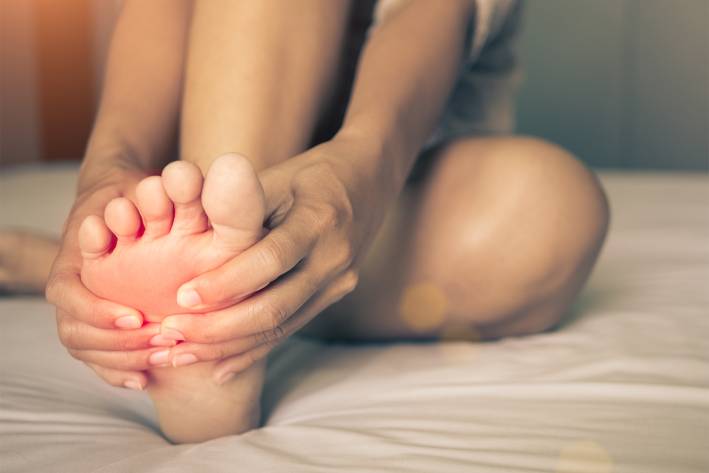Your feet have a lot to tell you about your overall health.
How many times do you say, “I need to get off my aching feet” and then forget about them? It’s so important to pay attention to common foot problems and have a firm foundation underneath you. Look down at your feet. Those small appendages are supporting the weight of your entire body. That’s no easy task, and the right footwear is essential for good foot mechanics.
According to the American Podiatric Medical Association, 80 percent of Americans report suffering from foot pain and other common foot problems. It’s not hard to imagine that when your feet aren’t happy, it radiates up to your knees, hips and even your back. It’s also not hard to believe that diseases affecting the rest of your body also show up in your feet.
What Common Foot Problems Say About Your Health
Cold Feet
Do your feet ice your partner right out of bed? Common causes of cold feet include poor blood circulation (often as a side effect of smoking), high blood pressure, heart disease, hypothyroid and anemia. Sympathetic dominance and adrenal fatigue cause increased blood flow to vital organs and less blood flow to extremities, making feet cold. While warm socks may take the chill off, increasing circulation by addressing the root cause is the best long-term solution.
Swollen Feet
Gravity isn’t always your friend. Blood and lymph flow are easy going down to the feet, but the veins have to carry it back, which have valves that open and close to work it back up to the heart instead of a pump. This means swollen feet are a common foot problem – usually temporary, often caused by standing or sitting for long periods, especially during travel or pregnancy. If your feet are swollen on a regular basis this can be caused by poor circulation, kidney issues, hypothyroid, impaired lymphatic drainage, or a blood clot.
Burning Feet
If you feel a burning sensation in your feet the first thing to check for is fungal infection. Signs of athlete’s foot can range from tightness and burning sensations in the skin to rashes, cracks and fissures in the skin, and more. If no infection is present, then check for B vitamin deficiencies, poor circulation from Peripheral Artery Disease, diabetes, and chronic kidney disease. If a podiatrist finds blockages in the arteries of your feet, this is a sign you likely have arterial blockages elsewhere in your body.
Itchy Feet
Skin that is itching and scaling is most commonly caused by the Athlete’s foot fungal infection, but can also be a sign of psoriasis, an autoimmune condition. In the case of psoriasis, the skin is thicker and may have a red, raised rash in the areas of the peeling skin. You can also have an allergic reaction to skin care products or a reaction to chemicals your feet are exposed to. This is known as contact dermatitis, and usually goes away on its own once the source of irritation is removed. Borage oil taken internally is a great ally to soothe irritated skin.
Toenail Issues
Your toenails can tell you a lot about your health.
White Toenails
White toenails that separate from the nail bed can be caused by injury, nail infection, or psoriasis. Systemic illnesses like liver or kidney disease, or congestive heart failure can also cause white toenails, but these nails don’t life up from the nail bed or appear inflamed.
Yellow Toenails
Thick, yellow toenails can be caused by fungal infection, lymphatic drainage issues, lung disease, psoriasis, or rheumatoid arthritis. Spoon-shaped toenails that curve up at the end are a sign of frequent exposure to petroleum products and solvents or a sign of anemia and iron deficiency.
Rounded or Sloping Toenails
If you notice your toenails becoming more rounded and sloping downward, this is clubbing and can be a sign of lung disease and problems with oxygen absorption. Less commonly this can be caused by heart disease, liver disease, digestive disorders, infections, or even heredity.
Change in the Color of Your Toes
Raynaud’s disease can cause toes to first turn white, then red, and sometimes even blue in response to change in temperature or stress. Raynaud’s is often related to autoimmune thyroid diseases, Sjogren’s disease, and rheumatoid arthritis, so if you have red, white or blue toes, it’s time to get this evaluated.
Losing the Spring in Your Step
If you notice you’re starting to trip more easily or your feet are dragging, you may be losing sensation in your feet, which is caused by nerve damage from diabetes, nutrient deficiency (B vitamins), infection or alcoholism. If your gait is widening or you notice a foot drop, where your feet seem to almost slap the ground as you walk, these are signs of spinal cord issues (most commonly low back), neurologic diseases and muscle disorders. It’s time to seek professional help if your gait has changed.
Foot Sores That Don’t Heal
If you have a sore on your foot that’s taking a long time to heal, this is a red flag for diabetes. Both diabetes and peripheral artery disease impair circulation and sensation in the feet, making sores prone to slow healing and infection. In both these cases regular foot checks are essential for staying healthy.
Dark Spots on Your Feet
A dark spot anywhere on the feet or even underneath the nails isn’t likely to be an infection, but could be a melanoma skin cancer, which pops up even in areas that aren’t regularly exposed to the sun. Make sure you get any dark spots checked out by a dermatologist – you want to catch this deadly cancer as quickly as possible.
The Many Causes of Foot Pain
Start with Your Shoes
The most common cause of foot pain by far comes from ill-fitting shoes. The most stylish shoes are the biggest culprits in foot distress, but you may be surprised to find they aren’t the only villains. There are 4 main types of shoes to stay away from:
-
Tapering Toe Boxes
The natural shape of the foot is widest at the toes and tapers in toward the heel. However, most shoes for women and men – from athletic shoes and casual shoes to dress shoes – taper in at the toe. High-heeled shoes are the most notorious culprit – often tapering to a sharp point. Toes can’t conform to this shape, so the result is everything from toe deformities, bunions, and osteoarthritis, to pain disorders that extend all the way up into the knee, hip, and low back.
-
Raised Heels of Any Size
There is no heel height that’s sensible – not even cowboy boots. Any heel elevation shortens the tendons and muscles in the back of the leg as well as impairing the natural blood flow. There are women who have worn heeled shoes for so long that the posterior tendons and muscles have shortened to the point they can’t walk barefoot or in flat shoes without pain and deformity. Wearing shoes with an elevated heel also changes your normal gait and eliminates your natural arch support. Wearing heels changes the alignment of the body from the ball of your foot all the way up to your pelvis, which has to tilt back to accommodate the change in the pull of gravity forward. This not only impacts the back but also the pelvic organs.
-
Shoes with Toe Spring
Most common in athletic shoes, any shoe that turns up at the toes overstretches the tissues on the bottom of the foot and can lead to plantar fasciitis, neuromas in the ball of the foot, and even shin splints. If your shoes are flexible and lightweight, you can minimize toe spring by folding the shoes in half with the sole of the toes touching the sole of the heels and placing it under a heavy object to hold it in this shape for up to 48 hours.
-
Inflexible Soles
Shoes with a heavy, inflexible sole – including arch supports – prevent the necessary flattening of the arch during walking. They also reduce the sensitivity to the terrain you’re walking on and you’re more likely to misstep, causing injury and balance issues. A rigid sole limits the range of motion of the foot much like a cast does, and can cause atrophy of the foot muscles, making them dependent on orthotics or extra cushioning to be able to function.
Stealth Pain
Another common cause of foot pain is stress fracture, from intense exercise, like distance running or basketball. Weakened bones from osteopenia or osteoporosis increase this risk. If you have intense or nagging foot pain that persists no matter what you do, get an x-ray to make sure you don’t have a stress fracture.
Heel Pain
If you feel heel pain first thing in the morning when you hop out of bed, chances are you’re suffering from plantar fasciitis, a common inflammation of this long ligament that attaches to the heel bone. Stretching exercises, ice (fill a 12-20 ounce plastic bottle with water, freeze, then roll under the arch of the foot), therapeutic ultrasound, and kinesiotape work wonders with plantar fasciitis. A good physical therapist can’t be beat when it comes to this common painful problem.
Other causes of heel pain include bone spurs, tendonitis, arthritis, fracture, tumor, or infection. Excessive exercise or wearing one of the 4 types of shoes that cause foot pain are also common causes.
Foot Spasms
There’s nothing worse than having a muscle spasm in your foot while wearing laced up shoes or boots. Rubbing or massaging the spasm out is the quickest way to relief. Long-term relief comes from testing for nutrient deficiencies, like Vitamin D (a blood test), or mineral imbalances, like calcium, potassium, and magnesium.
Make sure you’re not dehydrated or overworking tired foot muscles, and check your circulation as well as the fit of your shoes. If you are pregnant or have a thyroid disorder, this can also cause frequent muscle spasms in the feet.
Toe Pain
Big Toe Pain
Sudden pain, heat, swelling and redness at the base of the big toe are the hallmarks of gout, an inflammatory condition which causes an increase in uric acid and a painful, swollen joint. If the pain is worse in the morning, the joint is stiff, and there’s no heat or redness, then osteoarthritis is the likely culprit. If it’s difficult to bend the joint you may have developed a bone spur as a complication of the arthritis. If the pain comes on suddenly as a result of an injury, you may have turf toe, a common ailment of athletes who play on hard surfaces.
Pain in Other Toes
If you have burning pain in the ball of your foot that radiates to your middle toes, or feel like you’re walking on a marble, then you may have a Morton’s neuroma, which is the thickening of tissues around a nerve, caused by injury or pressure on the toes from ill-fitting shoes or high heels. Not surprisingly, this foot issue is 10 times more common in women than it is in men.
Toe Deformities
Toes that bend upward then curve down at the end, resembling a claw are called claw toes. Claw toes can be caused by shoes that are too tight or by diseases that damage nerves, like diabetes, neurologic disorders, or alcoholism.
If the joint on one of your toes is pointing upward rather than lying flat, you may have a hammertoe or mallet toe. These happen when the muscles in the toes and ball of foot aren’t working together correctly, usually caused by wearing high-heeled shoes. Caught early, all of these deformities can be helped by stretching and toe exercises, but prescribed shoes and even surgery may be necessary.
Find Relief by Returning Your Feet to Their Most Natural State
Returning your feet to their most natural state is the best answer to most pain-related foot problems, as well as the musculoskeletal problems that are an extension of these issues. Wear shoes that support the natural alignment of your feet and allow them to move and stretch freely, working all the small muscles that support and give the feet strength in all directions. Stretch and strengthen your feet, and consider reflexology, massage, and physical therapy when dealing with pain, deformities, or transitioning from any of the 4 types of shoes that cause foot issues.





